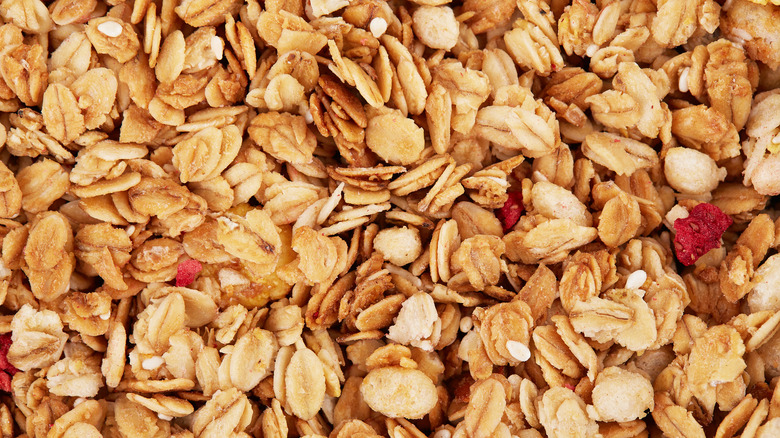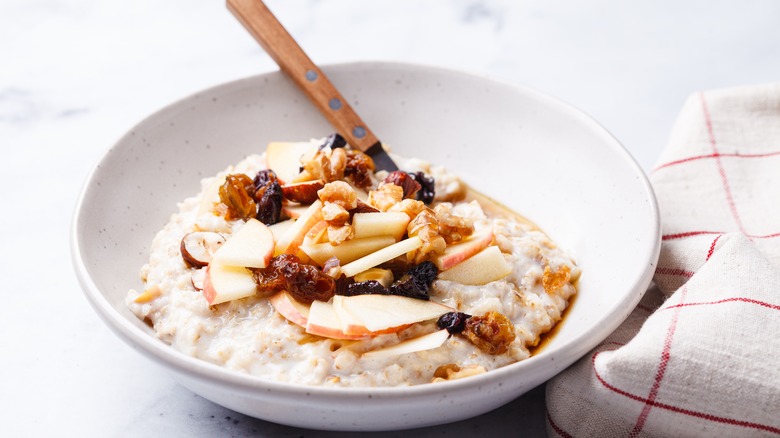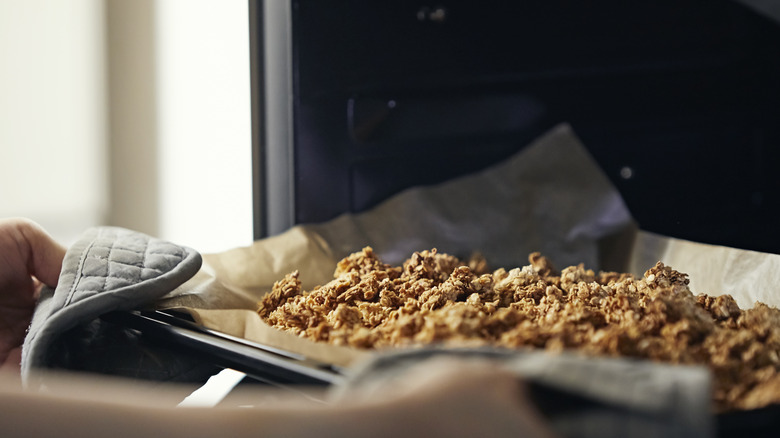Granola Vs Muesli: What Makes Them Different?
Breakfast people have a tough decision to make every morning. There are so many delicious options, whether you want to satisfy your sweet tooth with a pile of pancakes or go for a savory egg sandwich; but, for those in search of a sustaining combination of tasty elements that each bring their own benefits to the table, the choice may come down to muesli or granola. Perhaps the biggest question when making this call is: What's the difference?
If you were to compare ingredient lists, you may not be able to tell the difference between these two. They both typically contain a blend of grains, nuts, and seeds, sometimes along with additions like dried fruit, coconut flakes, cacao nibs, and flavorings like spices. You can even serve them in similar ways, like garnished with fresh or dried fruit and a drizzle of honey or maple syrup. Both can be enjoyed simply with a splash of milk as a breakfast cereal substitute and are quite easy to make at home — not to mention super customizable.
The primary differences lie in one or two ingredients, as well as the preparation method. But it helps to have a little backstory on each to contextualize how these two breakfast classics came to be.
What's the story with muesli?
Muesli has origins in Europe — specifically, an early 20th-century Swiss sanatorium, where one doctor and nutritionist believed that raw food was fundamental to health and healing. As part of his prescription for patients, Dr. Maximilian Oskar Bircher-Benner put together a schedule that included, among other things, daily walks and gardening, fresh air — and a bowl of muesli. At the time, Dr. Bircher-Benner's dish (called Birchermüsli) featured raw apples, along with ingredients more familiar to modern interpretations, like oats and nuts. While the formula for muesli has changed, that preparation style — to combine ingredients without cooking — remains a defining quality today.
Contemporary muesli recipes can have a range of ingredients, many of which also feature in granola. However, the finished product has more in common with overnight oats or classic breakfast cereal. Once a batch is mixed up (which can be stored in an airtight container and last about a month), preparing muesli is as simple as adding milk (or a non-dairy equivalent) and refrigerating overnight to soften and meld. Alternately, you can enjoy muesli like standard cereal with a splash of milk (as a great non-sugary breakfast option), or layer into a yogurt parfait.
Although muesli itself is uncooked, you can toast some of your ingredients, like nuts and grains. This step opens up flavors and aromas, adding depth and a comforting quality to your bowl, but stopping short of the kind of cooking required of its cousin, granola.
What's the story with granola?
Although many culinary classics are the result of European influence, the invention of granola is American and actually predates muesli, first appearing in the late 19th century. The stories of their creation are similar, and in the case of granola, credit is given to New York doctor James Caleb Jackson —who also headed up a treatment facility. Rather than raw foods though, Jackson zeroed in on what he called pure foods, and his original cereal was graham cracker-based and twice-baked. Sounds tasty, but this recipe wasn't a runaway hit, and it also required a soak in milk to make it palatable. It wasn't until decades later, in the 1960s, that a contemporary, evolved version of granola gained popularity as an alternative to the super-sweet cereal options.
A major ingredient difference between granola and muesli, whether made commercially or at home, is that recipes rely on a sweetener like honey, sugar, or maple syrup, as well as oil, to keep those bits bound together. Granola is also baked and not raw, which is how you get those signature crunchy clusters.
There are a whole lot of commercial options for granola (we know, we ranked them) and muesli, too. And, although Ina Garten prefers store-bought granola rather than making it from scratch, it's a cinch to make both of these historic breakfast contenders, guaranteeing a satisfying bowl of goodness, no matter the time of day.


